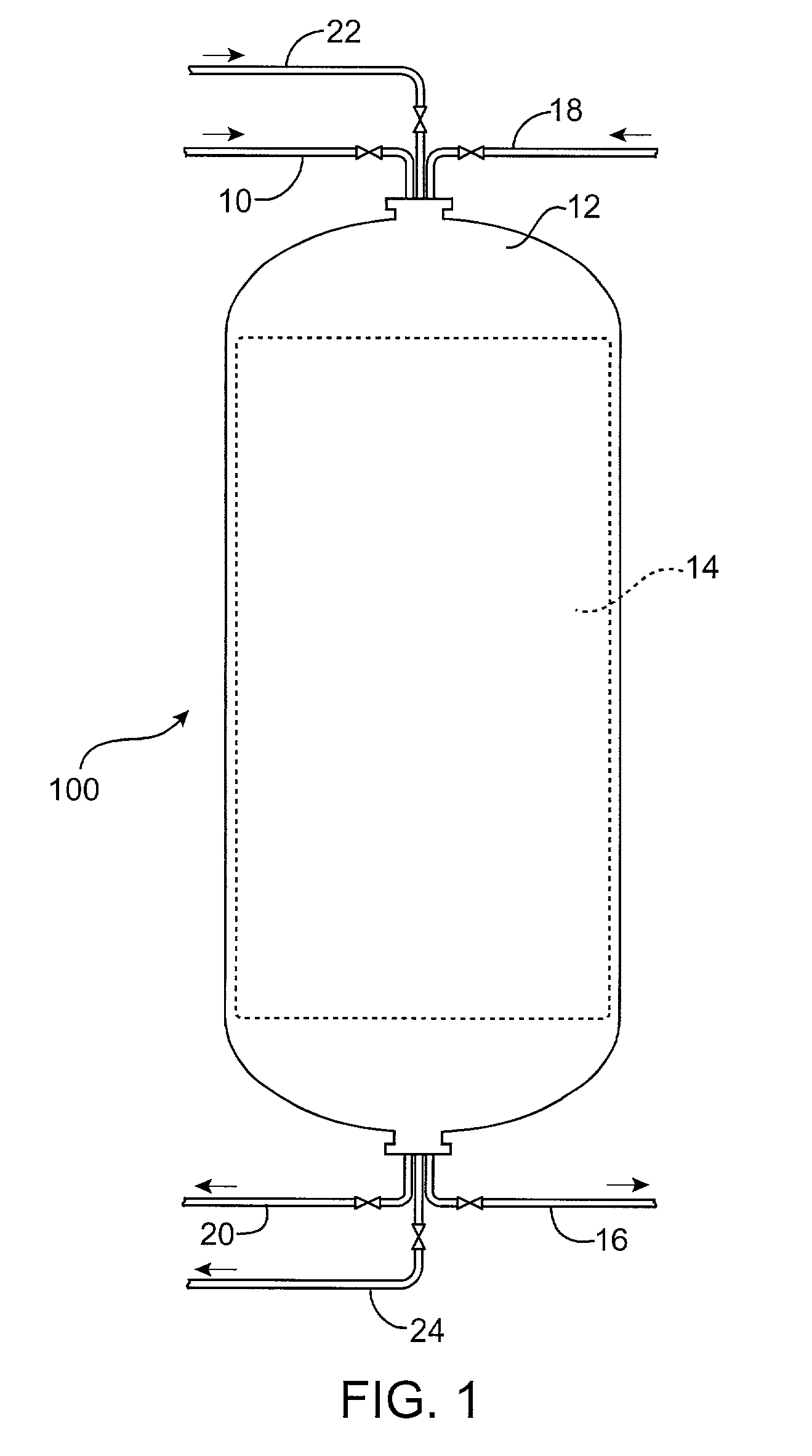High efficiency ion exchange system for removing arsenic from water
a technology of arsenic and ion exchange system, which is applied in the direction of moving filter element filter, filtration separation, separation process, etc., can solve the problems of large vessel size, increased operation and maintenance costs, and large valve size, and achieves easy maintenance, high process efficiency, and reduced waste water
- Summary
- Abstract
- Description
- Claims
- Application Information
AI Technical Summary
Benefits of technology
Problems solved by technology
Method used
Image
Examples
first embodiment
[0091] the overall system of the invention is shown in FIG. 7 as system 700. System 700 includes eighteen vessels 12-1 through 12-18, where eighteen is a representative number in the range of ten to twenty-five or greater. Each vessel is numbered with an identifier "1", "2" . . . "18 " to identify its unique position in the overall system. Each vessel is configured for cocurrent flow of treatment water and regenerant essentially as set out in FIG. 5 and is equipped with headers, manifolds, lines and valves as described with reference to FIGS. 4 and 5. These elements are numbered in accord with the numbering used in FIGS. 4 and 5 with an added indication if a particular element is associated with a particular vessel. For example, header "40-1" is the "40" header associated with vessel 1.
[0092] Each of the eighteen vessels contains a bed of ion exchange resin and each has a header 40-1, etc which provides access to the vessel and to contaminated water supplied by feed manifold 48, via...
second embodiment
[0105] the overall system of the invention is shown in FIG. 8 as system 800. System 800 includes sixteen vessels 12-1 through 12-16. The numbering of elements of the process is in accord with the numbering used with FIG. 7. Arsenic-contaminated water is feeding through the resin beds in vessels 12-1 through 12-13. Purified water is being withdrawn from these thirteen vessels through headers 42-1 and valve 64-1, etc and collected in manifold 50 for use. Again, valves 64-1 through 64-13 all are shown with a dot to show a positive fluid flow.
[0106] Vessels 12-14 through 12-16 are not in service removing arsenic and purifying water. The resin beds in vessels 12-15 and 16 are undergoing regeneration with a brine solution and the bed in vessel 12-14 is being rinsed to remove spent brine prior to being returned to service. As noted above, this regeneration could be carried out with substantial volumes of regenerant and rinse going to waste but such a process would be undesirable for waste ...
example 1
Arsenic Removal
[0157] The system of the invention is useful for removing arsenic from water. An overall process is illustrated in FIG. 13.
[0158] The ion exchange unit was substantially in accord with system 800 in FIGS. 8 and 13. Since this was a test system, the number of vessels was reduced to six, three in absorption, two in regeneration and one in rinse. In a commercial scale unit, additional vessels would be present in service in absorption for a total of at least 10 vessels. The beds were each 36 inches in diameter and about 48 inches deep. Treated water was removed via line 136.
[0159] The water being treated was fed through line 130 to oxidizer 132 and had the following representative composition.
1 Anions 2.93 mg / L Ca 20.00 mg / L Cl 7.60 mg / L Mg 13.00 mg / L Mn 79.00 mg / L NO.sub.3 1.00 mg / L K 24.00 mg / L Na 22.00 mg / L As V 0.012 mg / L As III 0.011 mg / L
[0160] This water feed was treated with chlorine (0.2 mg / L) (0.2 ppm) to oxidize the AsIII to AsV. Any equivalent oxidizer, such as...
PUM
| Property | Measurement | Unit |
|---|---|---|
| diameter | aaaaa | aaaaa |
| depth | aaaaa | aaaaa |
| depth | aaaaa | aaaaa |
Abstract
Description
Claims
Application Information
 Login to View More
Login to View More - R&D
- Intellectual Property
- Life Sciences
- Materials
- Tech Scout
- Unparalleled Data Quality
- Higher Quality Content
- 60% Fewer Hallucinations
Browse by: Latest US Patents, China's latest patents, Technical Efficacy Thesaurus, Application Domain, Technology Topic, Popular Technical Reports.
© 2025 PatSnap. All rights reserved.Legal|Privacy policy|Modern Slavery Act Transparency Statement|Sitemap|About US| Contact US: help@patsnap.com



